
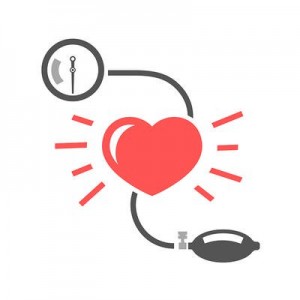 November 2017 new blood pressure (BP) guidelines were released. This is the first comprehensive set of guidelines since 2003. The big change is the lowered definitions for high blood pressure. The American College of Cardiology (ACC) and the American Heart Associations (AHA)(along with several other health organizations) are making these new recommendations to account for complications that can occur at lower numbers and to allow for earlier intervention. This is a good thing.
November 2017 new blood pressure (BP) guidelines were released. This is the first comprehensive set of guidelines since 2003. The big change is the lowered definitions for high blood pressure. The American College of Cardiology (ACC) and the American Heart Associations (AHA)(along with several other health organizations) are making these new recommendations to account for complications that can occur at lower numbers and to allow for earlier intervention. This is a good thing.
The old numbers were 120/80 mm Hg as normal. Additionally, hypertension was identified at 140/90 mm Hg. The new guidelines are quite different, introducing two stages of increasing hypertension. Systolic, the top number, is the amount of pressure (measured in millimeters mercury and denoted as mm Hg; Hg is the period tables’ symbol for the element mercury) in your arteries during contraction of the heart muscle. Diastolic, the bottom number, refers to your blood pressure when the heart is between beats. Here are the new guidelines:
- Normal: Less than 120/80 mm Hg;
- Elevated BP: Systolic between 120-129 and diastolic less than 80;
- Stage 1: Systolic between 130-139 or diastolic between 80-89;
- Stage 2: Systolic at least 140 or diastolic at least 90 mm Hg
If you’re above 180/120, well, you’re a hypertensive crisis just waiting to happen. The new guidelines eliminate the category of prehypertension, categorizing patients as having either Elevated (120-129 and less than 80) or Stage I hypertension (130-139 or 80-89).
Uncontrolled high blood pressure (HPB) can lead to stroke and contribute to cardiovascular (heart) disease. Contributing risk factors are:
Family history – if it runs in the family, there is an increased chance you can get it.
Age – the older you are the more likely you are to get HBP. As we age our blood vessels lose some of their elastic quality which can contribute to increased blood pressure.
Gender – Men are more likely to get HBP than women are (until age 45). Women catch up to men after age 45 and are at equal risk as men until about age 65, where women are more likely to get HBP.
Race – African Americans are at greater risk for HBP than any other race in the United States.
Lack of physical activity – Physical activity is good for your heart and circulatory system.
Unhealthy diet (especially high in sodium) – A diet too high in salt consumption, calories, saturated fat and sugar puts you at greater risk for HBP. Recommended dietary allowance for salt is 2300 mg/day, about 1 and ¼ teaspoon.
Being overweight/obese – too much weight puts extra stress on the heart and circulatory system.
Drinking too much alcohol – consistent heavy use of alcohol can cause many health problems, one of them being HBP.
Smoking/tobacco use – smoking and tobacco use temporarily increases your blood pressure putting strain on the arteries and the heart
Stress – too much stress may contribute to increased blood pressure.
You can’t change your gender, race, age or family history but the last six risk factors are related to lifestyle, which means these are things you can change. If you’re not sure about your blood pressure or even think your blood pressure could be high, schedule an appointment with your doctor. The blood pressure machines found by the pharmacy section of many grocery stores can be used if you’re not sure. Allow yourself a minute to relax before taking your blood pressure and be sure to sit straight and with feet flat on the floor. Avoid conversation too. Additionally, if you have elevated blood pressure, monitoring this at home is not a bad idea. The new guidelines have thrown prehypertension folks into the hypertension category and early prevention can help put you on a better track to lower your blood pressure and lower your risk of stroke.
The new ACC/AHA guidelines were developed with nine other health professional organizations and were written by a panel of 21 scientists and health experts who reviewed more than 900 published studies.
Yours in health,
Samantha L. Madsen, MS, CSCS
“Train Smart. Eat Healthy. Rest Well. Supplement Wisely.”
Posted by: Samantha in
Nutrition on November 17th, 2017
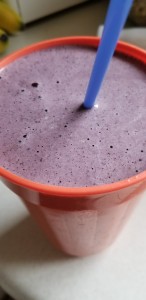

Do you know how much calories and sugar are in that protein drink or green smoothie you are consuming? Well, I was not exactly sure either but had a guestimate. Yesterday I put together all the numbers for calories, fat, carbohydrates (CHO), sugar, fat and fiber for my daily protein shake. To my surprise my CHOs and protein content were about even, with CHOs slightly exceeding protein. Bonus is that the sugar content is not too bad and comes almost all from the fruit of a medium to lower glycemic variety (won’t spike insulin). The surprise was the amount of fiber and that it came in under 300 calories. Here are my ingredients and the results:
½ c. water
½ c. Unsweetened Almond Milk
1 c. Kale
½ Frozen Organic Blueberries (highest in anti-oxidants)
½ Banana (medium)
1 TBSP Flax Seeds (7x more lignans by weight than sesame seeds but must be ground to be of benefit)
1 heaping scoop vanilla Protein powder (whey/casein blend)
1 ¼ c. Ice cubes (to give thickness)
Calories: 289.5
Fat: 5g
CHO: 35g
Sugar: 16g
Fiber: 5.5g
Protein: 29g
Why did I do this? I drink this almost every single day after the gym. There are a lot of places like Whole foods, Trader Joes, and sometimes your gym that pedal green, fruit and/or protein smoothies. You want to know how many calories you’re getting and how much sugar because this could be the culprit as to why you are struggling with those few extra pounds or maybe getting rid of that stubborn mid-section. I have been saying this for almost three decades now, it’s not the fat that is killing us, it is the sugar.
Yours in health,
Samantha L. Madsen, MS, CSCS
“Train Smart. Eat Healthy. Rest Well. Supplement Wisely.”
Posted by: Samantha in
Wellness on January 13th, 2017
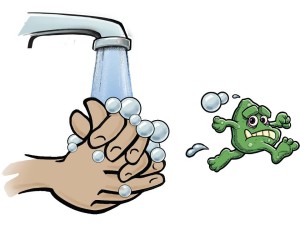
Oh my goodness it’s that time of year again! Surrounded by coughs, sniffles and germs, germs, germs! Well, were always surrounded by germs but this time of year, they make us sick. Here are a few strategies to implement to guard your health and deter those little germs sticking in your system!
Wash your hands regularly and thoroughly. This can’t be emphasized enough! Often germs are transferred from our fingers to mucus’s in, on and around the orifices of our face including the eyes. When you find yourself reaching to your face ask yourself, “When was the last time I washed my hands?” While washing, don’t forget to clasp your hands together, getting between the fingers. And it goes without saying to avoid sharing objects.
Keep yourself hydrated! Truthfully, most Americans walk around dehydrated. Water is used in thousands of enzymatic reactions that occurs in the body for maintaining homeostasis (physiological equilibrium). Our human system is 60 percent water for men and 55 percent for women on average. Fat tissue carries less water than lean tissue. If you feel thirsty you’re well past the need for water as this mechanism is a slow feedback loop to the brain. When I say water I’m talking about the clear stuff with no calories. Not juices, fruit or otherwise, soda, or any other of multitude of beverages on the market. If you must use something in your water in order to drink more you can use the low calorie sweetened flavorings available, but try diluting them so you can decrease your dependency on the need for sweetness in your drinks. Shoot for about a gallon of water a day. That’s 128 ounces.
Stay rested. I know, this can be tough with how busy our lives are. The Sleep Foundation recommends that adults age 26-64 get between 7-9 hours of sleep and ≥ 65 get between 7-8 hours a night. If your body is well rested, it’s better able to vigorously fight off exposure to germs that want to make you sick.
Getting enough color in your diet! That means vegetables, vegetables and more vegetables! Okay so I just opened Pandora’s box. But guess what? When your body is properly equipped with the chemicals it needs to stave off sickness it does a mighty job in the fight! A colorful diet rich in vegetables, legumes, and fruit means a robust immune system because these foods are loaded with phytochemicals—the power source for aiding the body in fighting illness and disease! Trust me this is a whole other discussion which actually I plan to delve into in great detail later in the year. Seven to nine servings of vegetables are recommended by the American Dietetic Association—so crunch up!
Get regular exercise. More and more research is showing that exercise is necessary for optimal health. To such that the lack of exercise puts you at as great of risk for unwanted diseases and sickness as smoking. Yes, the lack of exercise can negatively impact your health. The evidence is irrefutable. Get moving if you’re not, and stay moving if you are!
A word on supplements. I’m a big fan. Herbs, tinctures, vitamins, minerals, etc., for the most part they’re great. Caveat, supplements are supplements and meant to be supplemental to a good diet and healthy lifestyle. They will not fix a crappy diet or lack of exercise. Take them wisely.
Yours in health,
Samantha L. Madsen, MS. CSCS
“Train Smart. Eat Healthy. Rest Well. Supplement Wisely.”
Posted by: Samantha in
Nutrition on September 14th, 2016

I was leaving my girlfriend’s house having just picked up something and she sent me off with a sandwich bag of pear and cherry tomatoes from a friend’s garden. By the time I arrived home the bag only had a few remaining tomatoes—I’d eaten most of them during the drive! Home grown tomatoes, yum! Late summer early fall tomatoes come into season and if you grow your own or are fortunate enough to have family and friends that grow them and share them with you oh what a delicious treat! It made me ponder on the wonderful goodness of this fruit! They come in so many different shapes, sizes and varieties! There are the snack size tomatoes like cherry and pear sizes. There are tomatoes that are great for cooking like roma and plum tomatoes. There’s the beefsteak and celebrity tomatoes that work lovely on sandwiches! There are literally hundreds of varieties! They come in different colors too, ranging from green, yellow to orange to deep red and even a dark purple color. They’re also low in calories—about 32 calories in a cup of chopped tomatoes—and a very low glycemic index number to boot.
Besides being utterly delicious tomatoes are good for you! They are one of the best sources of lycopene you can find! Lycopene is a phytochemical and part of the carotenoid family. It’s a powerful antioxidant that may protect cells from damage. There’s a great deal of research interest on Lycopene’s effect, if any, on preventing cancer. Early research has demonstrated Lycopene’s ability to reduce prostate tumors. Other research with Lycopene is in the areas of bone health in slowing down osteoporosis, cataracts and macular degeneration because of Lycopene’s natural UV protection, heart disease, and atherosclerosis (hardening of the arteries). It’s Lycopene’s strong antioxidant properties that make it such a great interest in research of disease.
Interestingly, processing tomatoes with heat (during canning, making paste, or spaghetti sauce) does not adversely affect Lycopene. In fact, it makes the Lycopene even more readily absorbed. So, slice them, dice them, chop them in a salad or put them on your sandwich! Cook them, can them or sauce them! I just finished eating a whole celebrity one over the sink! Hmmm….tomato love!
Yours in health,
Samantha L. Madsen, MS, CSCS
“Train Smart, Eat Healthy, Sleep Well, Supplement Wisely”
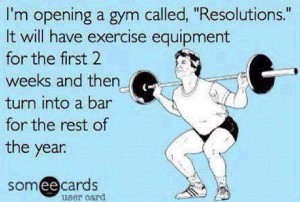
Are you one of the millions of folks that made a New Year’s resolution? We’re into February, have you stuck with it? If not, why? More importantly, does it matter to you? It’s important to analyze this. It’s estimated that 45 percent of American’s make New Year’s resolutions with about 66 percent of those being fitness goals. By the time February rolls around most resolvers have abandoned their New Year’s resolution. Top reasons include being too busy or not being committed to their goals in the first place. Is this you?
Setting goals and being able to achieve them is a learned skill. You don’t come out of the womb armed with goal setting abilities. To be successful in achieving goals there’s certain things you need to want or put in place. Number one, you have to have the desire for your defined goal. You have to want it! If you’re simply joining in what everyone else is saying because it sounds good and you need to lose weight it’s not going to be effective. Every goal requires work, energy, and focus therefore you’ve got to want it enough to be able to concentrate your efforts in that direction.
Saying I want to lose weight or I’m going to begin an exercise program is too general. You have to be specific about your goals. They need to be clearly defined by not only what it is you want to do but how long it’s going to take you to achieve them. In example, losing 30 pounds over a 16 week period offers some detail. This forges a sort of concreteness to your goal as you clearly defined exactly what it is you want to do and over what time period. Beginning an exercise program you would set yourself up for success by defining the number of times per week you plan on exercising, the duration of that exercise, and the activity of the exercise. And don’t be over zealous on this one! A common error! Telling yourself you’re going to go to the gym six days a week when you haven’t been to the gym in years is setting yourself up for failure. Be realistic.
Now that you’ve clearly defined and specified what your goals are you need to share this with someone. This gives ownership to what you’re trying to accomplish and it also provides a confident to share in your successes. I also strongly urge writing down the specifics of your goals and keep this visible; someplace you see it every day. Sometimes we just need to have it in our face as a reminder of what we want to accomplish.
Now you need to define what this pathway of success is going to look like, how you’re going to get there. This can be a little tougher as it requires specificity on how and what you’re going to do to accomplish your goal. If your goal is to lose 30 pounds over 16 weeks then you need to look at your current eating habits and make the necessary adjustments to facilitate weight loss or hire a nutritionist. This is a critical component for success because this is about clarity in the details and needs to be recorded for visualization. If you work long hours and your goal is to go to the gym to lift weights and do cardio for 60 minutes three times per week you need to decide when and where you’re going to carve out the time to do so and lock those dates in. Clarity.
Now once the specifics of your goals are clearly defined you simply go to work. They say variety is the spice of life and so is true for consistently maintaining an exercise regime or long term food goals. Having a plan makes all the difference in leading to your success. The military has a saying, “Fail to plan, plan to fail.” Pretty straight forward and right on the nose!
Within the confines of your over-all goal, define moments of achievement. In the weight loss goal for example, when you lose those first ten pounds celebrate your win! But not with food! Reward yourself with something outside of the food arena, like a new blouse or pair of shoes, or a massage or facial. Allowing yourself to enjoy wins along the way to your goal not only provides encouragement for what you’ve accomplished but it also helps re-train your brain about what those rewards should look like. You’ll find enlisting this behavior will transfer to other parts of your life as well.
We all have set backs. But what’s key is not allowing a bad day define you or your goal so don’t beat yourself up over a moment in time. It’s just that, a moment in time. There’s later in the day or tomorrow to regroup. Having this mind set is a powerful aid. Ever see a gymnast fall off the beam and then get back up and finish her routine without additional errors? This is the power of that mindset. It’s where you focus your energy and your time. Not in the fall which just cost half a point but in a flawless effort for the remainder of the routine. You have to let those bad moments roll off your shoulder and look optimistically forward to your next success.
There’s no time like the present now go out and get it done!
Yours in health,
Samantha L. Madsen, MS, CSCS
“Train Smart, Eat Right, Rest Well, Supplement Wisely”
Did you know that November is National Caregiver month? Well it is! Do you know someone who is a caregiver to a family member, friend, or loved one who is ailing with a chronic disease, terminal disease, or limited because of some handicap? If you do then take a moment to recognize these people and do something nice for them!
Caregivers are unique individuals blessed with a special spirit and love to offer the ongoing support and care they do. It is not easy to be on call and available 24/7 but these people do it because of the special type of people they are. Some take it on as a part of their daily life because their partner has taken ill, been in an accident, or been diagnosed with a disease. Others volunteer or offer to help out with specified times or when they can. Sometimes their job is a thankless one and not wholly appreciated by the person they’re caring for. Yet caregivers go on attempting to understand what it must be like being the one living with a disease or illness day in and day out.
So this month take notice of the caregivers you may know. Recognizing their hard work with a thank you is a very nice gesture. But do more than that if you can. Take them out to lunch or dinner or bring it in and enjoy a meal together, offer to provide a few hours of care and give them some time off, provide a gift card of some sort and then offer to be the caregiver while they enjoy the gift card, offer to help out with much needed tasks or chores, or think of something unique on your own! Caregivers need caring for too! Let’s not forget all they do for us.
Yours in health,
Samantha

My hiking partner, Steve, and I put in the 20 miles (round trip) to Red Castle’s Lower Lake in the high Uinta’s in one day (October 2015). In order to get an early start at the China Meadows Trailhead we stayed the night before in Laramy, WY. It was still an hour drive to the China Meadows trail head, with about half of it being a well maintained dirt road. While we left the hotel around 6:20 am we didn’t start on the trail till 8:04 AM. The temperature was a cold 32 degrees. It had rained the night before so the ground was damp and we figured the trail would be a bit muddy as well.
For this hike I would definitely recommend hiking poles. Steve had them but I didn’t. The trail was rocky and with the rain the night before it was also muddy with water puddles scattered along the trail. Having four points on the ground versus only two allows you to move more quickly and safely through the rougher areas, especially as the miles accumulate and the legs tire.
Total elevation gain over the 10 miles to the lake was only 1,280 feet. We started out with overcast skies and the sun made intermittent appearances throughout the day. A good portion of the hike is within the tree line with the occasional meadow off to the side.  Because of the freezing temperatures, the pine and quaky trees had ice on the branches and as the temperature rose above freezing the ice began to melt. In some cases it felt like it was raining because of the constant dripping of melting ice. As our elevation increased, what was rain at lower elevations was snow up here and much of the surrounding area was scattered with flakes of snow. The mountains in the distance were covered. We reached Red Castle Lake in 4 hrs 50 min. Final elevation 11,000 feet. Red Castle was stunning and majestic! It almost looks a little out of place with its red colored rock against the pines and quake’s. We took 20 minutes to eat lunch and admire the view and take a few pictures. It looked like we might be caught in a squall so we did not dally long. In fact, as we headed out it began to snow, a peppercorn type of snow for about a mile before clearing up. The return trip took 4 hrs and 15 minutes, arriving at the trail head at 5:31 pm. Hiking 20 miles in one day definitely builds fortitude! I would say the last three miles were the toughest.
Because of the freezing temperatures, the pine and quaky trees had ice on the branches and as the temperature rose above freezing the ice began to melt. In some cases it felt like it was raining because of the constant dripping of melting ice. As our elevation increased, what was rain at lower elevations was snow up here and much of the surrounding area was scattered with flakes of snow. The mountains in the distance were covered. We reached Red Castle Lake in 4 hrs 50 min. Final elevation 11,000 feet. Red Castle was stunning and majestic! It almost looks a little out of place with its red colored rock against the pines and quake’s. We took 20 minutes to eat lunch and admire the view and take a few pictures. It looked like we might be caught in a squall so we did not dally long. In fact, as we headed out it began to snow, a peppercorn type of snow for about a mile before clearing up. The return trip took 4 hrs and 15 minutes, arriving at the trail head at 5:31 pm. Hiking 20 miles in one day definitely builds fortitude! I would say the last three miles were the toughest.
Three things that I carried in I did not need on this hike: a pair of shorts, sunglasses, and sunscreen.
A tremendous day!
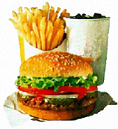
While it may seem obvious, we now have research showing a positive link between eating fast food, weight gain and diabetes. Up to this point there have been no long-term studies documenting the effect of fast food on obesity, type 2 diabetes and heart disease.
Data from a cardiac health study involving 3000 young people was used to determine if there is a link between eating fast food, weight gain and diabetes. Subjects in the 15-year study received a medical checkup and answered questions about diet, physical activity and other lifestyle factors.
After controlling for other factors, researchers determined that eating fast food twice a week or more was associated with a weight gain of 10 pounds over the course of the study. Fast food eaters had more than double the chance of developing insulin resistance, which is a predictor of type 2 diabetes and is also strongly linked to obesity.
Reference
Pereira, Mark A. et al. Fast-food habits, weight gain, and insulin resistance (the CARDIA study): 15-year prospective analysis. Lancet. 2005; 365: 36-42
Posted by: Samantha in
Nutrition on June 6th, 2013

Consumption of red and processed meat has been associated with colorectal cancer in many studies. Only a few studies have examined risk in relation to long-term meat intake or the association of meat with rectal cancer. The purpose of this study was to examine the relationship between recent and long-term meat consumption and the risk of colon and rectal cancer.
The subjects in this study consisted of 148,610 adults aged 50 to 74 years from 21 states with population-based cancer registries. The subjects provided information on meat consumption in 1982 and again in 1992 when they were enrolled in the Cancer Prevention Study II (CPS II) Nutrition Cohort. Subjects were followed from 1992 through 2001 to determine the incidence of colorectal cancers.
Subjects with the highest intakes of red and processed meat in both 1982 and 1992 had the highest incidence of colorectal cancer. Long-term consumption of poultry and fish was inversely associated with risk of colorectal cancer.
The results of this study demonstrate the value of examining long-term meat consumption in assessing cancer risk.
Reference
Chao, Ann. et al. Meat Consumption and Risk of Colorectal Cancer. JAMA. 2005;293:172-182.
Posted by: Samantha in
Obesity on June 6th, 2013

Health-care costs for morbidly obese adults are nearly twice those of people considered to be of normal weight, says a study led by University of Cincinnati (UC) researchers.
The study found that medical expenditures for morbidly obese adults in the year 2000 were 81 percent more than for normal-weight adults, 65 percent more than overweight adults, and 47 percent more than obese adults.
The excess costs among morbidly obese adults resulted from greater spending on visits to the doctor, outpatient hospital care, inpatient care and prescription drugs, the researchers say.
“The economic burden of morbid obesity among U.S. adults is substantial,” says David Arterburn, MD, assistant professor of internal medicine and researcher at the Institute for the Study of Health at UC’s Academic Health Center.
The study, led by Dr. Arterburn, appears in the Feb. 14, 2005 issue of the International Journal of Obesity.
In 2000, nearly 5 million U.S. adults were considered morbidly obese, bringing health-care spending associated with excess body weight to more than $11 billion that year.
Morbid obesity (defined as being 100 pounds or more over ideal body weight or having a body mass index (BMI) of 40 or higher), is rising twice as fast as obesity (BMI greater than 30) in the United States. Between 1990 and 2000, the prevalence of morbid obesity increased from 0.78 percent to 2.2 percent, representing a total of over 4.8 million morbidly obese U.S. adults in the year 2000.
The authors found that $56 billion in U.S. heath-care expenditures in 2000 were linked to excess body weight–a 12 percent increase from 1998.
“If the number of morbidly obese Americans continues to increase over the next decade, total U.S. health-care expenditures will likely continue to rise,” says Dr. Arterburn.
Morbid obesity is associated with a substantially increased risk of sickness and death from chronic health conditions such as diabetes, hypertension, cardiovascular disease and cancer.
The authors say further research is needed into specific interventions that will reduce the incidence and prevalence of morbid obesity and improve the health and economic outcomes of morbidly obese individuals.
Coauthors include Matthew L. Maciejewski, PhD, of the University of Washington, and Joel Tsevat, MD, professor of internal medicine and researcher at UC’s Institute for the Study of Health.
The research was supported by a grant from the Department of Veterans Affairs.
Dama Kimmon
University of Cincinnati
Older Posts »
 November 2017 new blood pressure (BP) guidelines were released. This is the first comprehensive set of guidelines since 2003. The big change is the lowered definitions for high blood pressure. The American College of Cardiology (ACC) and the American Heart Associations (AHA)(along with several other health organizations) are making these new recommendations to account for complications that can occur at lower numbers and to allow for earlier intervention. This is a good thing.
November 2017 new blood pressure (BP) guidelines were released. This is the first comprehensive set of guidelines since 2003. The big change is the lowered definitions for high blood pressure. The American College of Cardiology (ACC) and the American Heart Associations (AHA)(along with several other health organizations) are making these new recommendations to account for complications that can occur at lower numbers and to allow for earlier intervention. This is a good thing.












